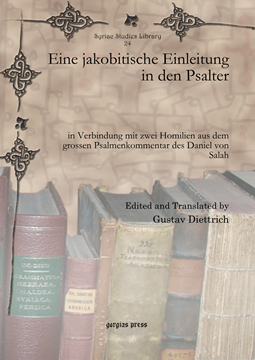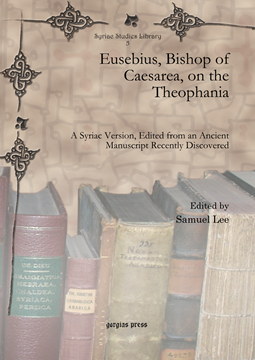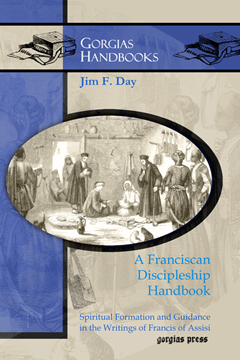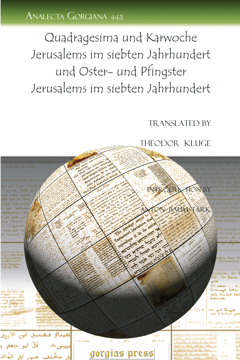The Treatise of Dionysius bar Salibi Against the Jews
Edited by J de Zwaan
Series: Syriac Studies Library 23
ISBN: 978-1-60724-828-6
This volume contains the Syriac text of one of Dionysius bar Salibi’s polemical writings, that against the Jews, based on a manuscript now located at the Harvard Semitic Museum. An English translation was promised by the editor, but never appeared.
$137.00 (USD)
Eine jakobitische Einleitung in den Psalter
in Verbindung mit zwei Homilien aus dem grossen Psalmenkommentar des Daniel von Salah
Edited and Translated by Gustav Diettrich
Series: Syriac Studies Library 24
ISBN: 978-1-60724-829-3
This volume contains the Syriac text, with German translation, of an (anonymous) introduction to the Psalms, together with two homilies from Daniel of Salah’s (fl. mid-6th century) long Psalms commentary. Diettrich’s detailed introduction adds richly to the work.
$167.00 (USD)
Eusebius, Bishop of Caesarea, on the Theophania
A Syriac Version, Edited from an Ancient Manuscript Recently Discovered
Edited by Samuel Lee
Series: Syriac Studies Library 5
ISBN: 978-1-60724-842-2
Samuel Lee arranges texts by the fourth century church historian Eusebius of Caesarea as they are known to him in their surviving Syriac versions.
$169.00 (USD)
The Book of Kalilah and Dimnah
Translated from Arabic into Syriac
Edited with an Introduction by William Wright
Series: Syriac Studies Library 6
ISBN: 978-1-60724-843-9
This second Syriac version of the famous collection of fables of Indian origin was translated from the Arabic version of ibn al-Muqaffa‘. Wright gives the Syriac text with notes, a lengthy introduction, and select glossary.
$218.00 (USD)
Kalila und Dimna
Syrisch und Deutsch
Edited and Translated by Friedrich Schulthess
Series: Syriac Studies Library 7
ISBN: 978-1-60724-844-6
From the storied transmission of this famous collection of Indian fables came two Syriac translations. This is an edition of the earlier translation (re-edited after the editio princeps) with German translation and notes.
$218.00 (USD)
The Konat Syriac Orthodox Anaphoras
Edited by Abraham Konat
Series: Kiraz Liturgical Studies 65
ISBN: 978-1-60724-849-1
This collection of eighteen Syriac Orthodox Anaphoras is an important source for scholars and clergy. Produced in Kerala by Abraham Konat, the son of the known scholar Matthew Konat, it is still used in the liturgical practices of the Syriac church.
$172.00 (USD)
A Franciscan Discipleship Handbook
Spiritual Formation and Guidance in the Writings of Francis of Assisi
By Jim F. Day
Series: Gorgias Handbooks 18
ISBN: 978-1-61719-238-8
St. Francis of Assisi is as popular today as ever before. This book deals with the training St. Francis received in undertaking the life of discipleship to Christ and the training St. Francis gave to others to help them live their vocation as disciples of Christ. St. Francis of Assisi was constantly aware of God's hand being ever operative in his own life. Helping others perceive God's direct and personal intervention in their lives highlights St. Francis' way of training others in Christian discipleship.
$57.00 (USD)
Theophany and Chaoskampf
The Interpretation of Theophanic Imagery in the Baal Epic, Isaiah, and the Twelve
Series: Gorgias Ugaritic Studies 5
ISBN: 978-1-61719-160-2
The imagery of thunder and lightning, fire and earthquake which attends YHWH's theophany in Old Testament poetic texts has most often been interpreted as a series of metaphors in biblical scholarship. This work applies insights from recent work in metaphor theory and myth theory to argue that this traditional interpretation of poetic theophanic imagery is mistaken, and that these texts make better exegetical sense when understood against the background of the ANE myth of the defeat of chaos.
$163.00 (USD)
Die armenische Rezension der syrischen Chronik Michales des Großen
By Felix Haase
Series: Analecta Gorgiana 442
ISBN: 978-1-60724-850-7
The Armenian version of the Chronicle of Michael the Great was overshadowed by the discovery of the Syriac version. However, Felix Hasse argues that the unique features of the Armenian text provide an important historical source for the Armenian tradition.
$39.00 (USD)
Quadragesima und Karwoche Jerusalems im siebten Jahrhundert und Oster- und Pfingster Jerusalems im s
Translated by Theodor Kluge; Introduction by Anton Baumstark
Series: Analecta Gorgiana 443
ISBN: 978-1-60724-851-4
Theodor Kluge publishes a German translation of two Eastern Christian liturgical texts for use in Holy Week, Easter and Pentecost. Anton Baumstark adds notations to the translation and includes an introduction to each text.
$41.00 (USD)









